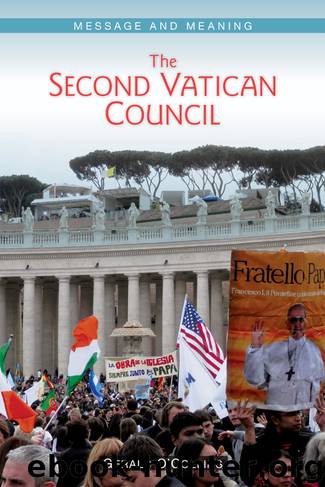The Second Vatican Council: Message and Meaning by Gerald O'Collins SJ

Author:Gerald O'Collins, SJ
Language: eng
Format: epub
Publisher: Liturgical Press
Published: 2014-07-29T16:00:00+00:00
Future-oriented
A tenth and final characteristic of presence is its future directedness. We live not only in virtue of what we already possess and enjoy but also in virtue of what is to come. Being open-ended projects, human beings are called to develop and grow in the various presences that shape their lives from cradle to grave. Nothing, not even the most wonderful and satisfying presence that we might enjoy, ever lasts but always proves fleeting. Relentlessly everything and the presence of every person pass away, as we move through life toward our final meeting with God, “the One who is, who was, and who is to come” (Rev 1:8). Every form of presence presses toward this future.
A future-orientation belongs essentially to all the sacramental modes of the risen Christ’s presence. Famously an antiphon for the feast of Corpus Christi (now the feast of the Body and Blood of Christ) declared that in the “sacred banquet [sacrum convivium]” of the Eucharist “we receive a pledge of future glory [futurae gloriae nobis pignus datur].” But all the sacraments, in their different ways, “announce the death” and resurrection of the Lord, “until he comes” (1 Cor 11:26). That means that a future directedness characterizes every sacrament and the presence of the risen Lord in any liturgical action.
Download
This site does not store any files on its server. We only index and link to content provided by other sites. Please contact the content providers to delete copyright contents if any and email us, we'll remove relevant links or contents immediately.
MOSES THE EGYPTIAN by Jan Assmann(2349)
Jesus by Paul Johnson(2278)
Anthology by T J(2128)
The Plantagenets by Dan Jones(1980)
Jesus of Nazareth by Joseph Ratzinger(1744)
By Design by J.A. Armstrong(1457)
The Courage to Be Happy by Ichiro Kishimi & Fumitake Koga(1334)
Saints for All Occasions by J. Courtney Sullivan(1325)
1916 in 1966 by Mary E. Daly(1199)
Abraham by James Reapsome(1182)
Who's Who in the Age of Jesus by Geza Vermes(1175)
Our Revolution by Bernie Sanders(1170)
Abraham by David Rosenberg(1145)
Global Crisis by Parker Geoffrey(1057)
Jesus: The Human Face of God (Icons) by Jay Parini(1049)
Crusade + Other Stories (Getting Started) by unknow(1049)
The Hare with Amber Eyes by Edmund de Waal(1043)
Stars by Sophia Bennett(1031)
God by Jack Miles(1023)
